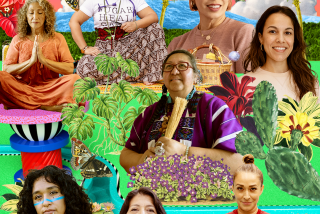Michelle Goldberg’s book ‘The Goddess Pose’ paints vivid picture of yoga pioneer Indra Devi
Millions of Americans practice yoga as a workout, a spiritual exercise or a combination of the two. Those who wonder if their pigeon pose or sun salute carry centuries of Hindu tradition from India to their sleek modern gym can relax. Change, adaptation and a dialogue between East and West have long been integral to yoga, something that comes through in Michelle Goldberg’s new book, “The Goddess Pose: The Audacious Life of Indra Devi, the Woman Who Helped Bring Yoga to the West.” (Alfred A. Knopf: $26.95, June).
Even if you don’t care enough about yoga to hold a pigeon pose for the length of time it takes to say that title, Indra Devi, born Eugenia Peterson in 1899 in Riga, Latvia, remains no less a fascinating character: Constantly searching as she moves from Eastern Europe to India to Shanghai and the United States, she changes names, marries twice, acts and dances — finally making it big about halfway through her century-long life as a yoga teacher, author and lecturer.
“One of the keys to her personality is that she was a stateless person and made a virtue of that,” Goldberg says by phone from New York. “There’s something almost supernatural about her willingness to get up and start over at almost any point in her life.”
Summer books: Fiction | Page-turners | Nonfiction | Kids | Lifestyle | Audio
Goldberg says that researching the book made her think about her own yoga practice in Brooklyn. “On the one hand, it’s obviously demystified yoga for me, both for good and for ill. There is a sort of magic to yoga when you don’t kind of quite know where it comes from and what is an ancient esoteric secret. So I guess it is a bit of a loss when you realize it’s British army calisthenics repurposed,” she continues. “At the same time, I used to have a bit of anxiety about authenticity that I’ve kind of gotten over.”
Goldberg is a widely published journalist who wrote “Kingdom Coming: The Rise of Christian Nationalism” and “The Means of Reproduction: Sex, Power and the Future of the World.” She started practicing yoga during a trip to India with her husband. While she “wasn’t sure she could chant ‘Om’ with a straight face,” she writes, she found no aerobics classes in the Himalayas.
Eventually, she became hooked on an “excruciating” ashtanga-style class. She came across Devi’s obituary while researching the connection between her Brooklyn class and the ancient idea of yoga.
Goldberg traces the independent spirit of the “Zelig-like” Devi to her childhood, often lonely and often missing her elusive mother. She grew up to believe that “personal spiritual development came before relationships.” Devi was said to have known or studied with the likes of the late yoga master B.K.S. Iyengar and India’s first prime minister, Jawaharlal Nehru, and to have introduced yoga to Kremlin leaders and Hollywood stars.
As history, Goldberg’s book is lots of fun, running through the Russian Revolution, the Weimar Berlin night life, Indian independence, 1950s Hollywood and 1960s counterculture. “The Goddess Pose” shows how Devi, and those around her, became attracted to yoga alongside what we might now call New Age philosophies and a desire for physical fitness.
Devi, or Peterson, as she was then known, first learned about yoga as a teenager in 1914, in the library of the Moscow home of family friends. The book she found there set off what became a deep desire to go to India, and those years set in Devi some of her lifelong traits. “All around her, the country was turning into hell — and she was learning a lesson that would serve her for the rest of her long life: how to survive her world collapse by reinventing herself,” Goldberg writes.
Yoga too would be repeatedly reinvented through history, migration and association with various philosophies. It had its own child abuse scandal, its stars, its value in various eras.
At the end of 1927, Devi said farewell to a fiancé and finally left for India, soon joining the traveling entourage of the renown Krishnamurti, at whose side, she wrote, “everything became clear and perfectly comprehensible.” (He would later make his home in Ojai.)
In the 1930s, hatha yoga began to gain a reputation as a “wholesome indigenous science of health and longevity,” Goldberg writes. While Indians had done yoga for thousands of years, their “practices didn’t necessarily have anything in common with yoga as currently understood by the West, as a series of poses and breathing exercises designed to strengthen the body and calm the mind.”
It was in that decade that Devi began her formal yoga training, eventually under the direction of the legendary teacher Tirumalai Krishnamacharya, who, after months of disciplined practice, told Devi to teach yoga in other countries. She was fearful, Goldberg writes, “but he was her guru. She couldn’t refuse.”
Her mother encouraged her to go to the United States, just as India’s independence neared. And in 1947 she left for Los Angeles, “the ideal place” for starting anew, Goldberg notes. Devi opened a yoga studio on the Sunset Strip and started to teach “a commonsense exercise and relaxation system, utterly practical and wholesome, promising transformative results without the grunting agony of other physical culture regimens.”
More to Read
Sign up for our Book Club newsletter
Get the latest news, events and more from the Los Angeles Times Book Club, and help us get L.A. reading and talking.
You may occasionally receive promotional content from the Los Angeles Times.







